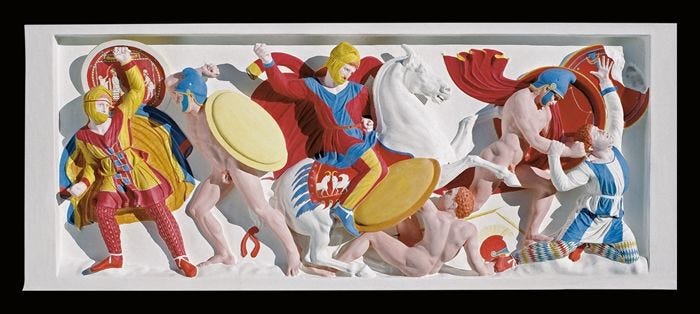Latest News - October 2022
Issue 13
In The Field…
First Temple Period Paleo-Hebrew Papyrus Recovered
The Biblical Archaeology Society reports the recovery of an extremely rare Paleo-Hebrew papyrus:
According to the Israel Antiquities Authority (IAA), an incredibly rare papyrus with Paleo-Hebrew text dating to the time of the First Temple has been recovered by its Antiquities Theft Prevention Unit. The IAA claims the papyrus, which contains just four lines of text, is one of only three papyrus documents to date to this period and, therefore, offers a unique glimpse into the world of Jerusalem during the time of the biblical kings. However, the papyrus is an unprovenanced object that may have originated on the antiquities market, which has caused some scholars to be more cautious when judging its date and authenticity.
Falcon Shrine Discovered in Ancient Greco-Roman Port town in Egypt
Archaeologists from the Sikait Project directed by Professor Joan Oller Guzmán from the Autonomous University of Barcelona (UAB), have uncovered a shrine containing previously unknown ancient ritual’s during excavations at Berenike, a Greco-Roman seaport in the Egyptian Eastern desert.
You can read more at the Universitat Autònoma de Barcelona and Heritage Daily.
2,000 Year Old Statue of Hercules Unearthed at Philippi
Archaeologists exploring an ancient Greek city have uncovered a large, 2,000-year-old statue depicting Hercules, a well-known figure from Greco-Roman mythology, the Greek Ministry of Culture and Sports revealed last month.
Researchers with the Aristotle University of Thessaloniki discovered the statue while sifting through the remnants of the ancient city of Philippi in northern Greece. Though they found the “larger-than-life” artwork in pieces, archaeologists believe the figure—depicted with a “youthful body”—originally held a club, a wreath and a lion skin, all of which have historically been associated with Hercules…
You can read more at the Heritage Daily and Smithsonian Magazine.
Mosaics Dating Between the 5th and 6th Centuries AD Discovered on the Shore of the Sea of Galilee
Archaeologists from the Johannes Gutenberg University Mainz (JGU) discovered mosaics in a settlement near to the early Islamic Caliph’s palace of Khirbat al-Minya on the shore of the Sea of Galilee.
[ … ]
Archaeologists also found stone structures made of basalt from varying periods, a water cistern, plastered walls and ornate mosaic floors.
The mosaics date from around the 5th to 6th century AD, depicting so-called Nile-scene images of flora and fauna native to the Nile valley in Egypt. Similar examples can be found in nearby churches, such as the Church of the Multiplication in Tabgha.
Quote of the Month
Bashfulness is an ornament to youth, but a reproach to old age. - Aristotle
Featured Publications
The Exodus: An Egyptian Story by Peter Feinman
Did the Exodus occur? This question has been asked in biblical scholarship since its origin as a modern science. The desire to resolve the question scientifically was a key component in the funding of archaeological excavations in the nineteenth century. Egyptian archaeologists routinely equated sites with their presumed biblical counterpart. Initially, it was taken for granted that the Exodus had occurred. It was simply a matter of finding the archaeological data to prove it. So far, those results have been for naught.
The Exodus: An Egyptian Story takes a very real-world approach to understanding the Exodus. It is not a story of cosmic spectaculars that miraculously or coincidentally occurred when a people prepared to leave Egypt. There are no special effects in the telling of this story. Instead, the story is told with real people in the real world doing what real people do.
Read more here.
Current Exhibits
Chroma: Ancient Sculpture in Color
Contrary to popular belief, most sculptures in the ancient Mediterranean world were colorful. Paint, gilding, and inlaid materials animated and enlivened marble, bronze, and terracotta figures. Over time, much of that polychromy—the term derives from the Greek for “many colors”—has disappeared, leaving representations of humans, animals, and mythical subjects without their original definition and ornamentation.
Chroma highlights ancient polychromy on works of art in The Met collection and reveals new discoveries of surviving color identified through cutting-edge scientific analyses and in-depth research by the Museum’s curatorial, conservation, scientific research, and imaging staff. The exhibition features a series of striking color reconstructions of major sculptures
More information can be found the Metropolitan Museum of Art website.
Artifact of the Issue
This black-figure amphora, or storage jar depicting two depicting two pairs of hoplites or foot soldiers engaged in battle, dates to roughly the late 6th century BCE. It was discovered in Athens, Greece. This was the typical style of ancient Greek artwork displayed on assorted jars and vases found throughout the Mediterranean world.










